

_COMMUNITY OF PRACTICE. The PLP model: Research-based professional learning. A vast body of literature underlies the connected learning communities model — our three-pronged approach at Powerful Learning Practice.
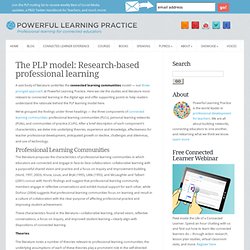
Here we cite the studies and literature most relevant to connected learning in the digital age and offer supporting points to help readers understand the rationale behind the PLP learning model here. We’ve grouped the findings under three headings — the three components of connected learning communities: professional learning communities (PLCs), personal learning networks (PLNs), and communities of practice (CoPs). Do.parkrose.k12.or.us/assets/files/departments/Student Services/9.26.11 Professional Development Handbook 2011-2012.pdf. Cultivating Communities of Practice: A Guide to Managing Knowledge - Seven Principles for Cultivating Communities of Practice.
In a new book, Cultivating Communities of Practice: A Guide to Managing Knowledge, the authors offer a practical guide to making knowledge work inside an organization.
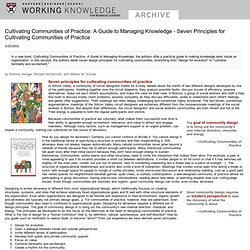
In this excerpt, the authors detail seven design principles for cultivating communities, everything from "design for evolution" to "combine familiarly and excitement. " by Etienne Wenger, Richard McDermott, and William M. Snyder Seven principles for cultivating communities of practice In Silicon Valley, a community of circuit designers meets for a lively debate about the merits of two different designs developed by one of the participants.
Huddling together over the circuit diagrams, they analyze possible faults, discuss issues of efficiency, propose alternatives, tease out each other's assumptions, and make the case for their view. Because communities of practice are voluntary, what makes them successful over time is their ability to generate enough excitement, relevance, and value to attract and engage members. 1. 2. My.plane.edu.au. My.plane.edu.au. Finding Time for Professional Development - Time Management Skills From MindTools. Making Learning a Lifelong Activity How to set aside time for learning. © iStockphoto/elias.kordelakos We now accept the fact that learning is a lifelong process of keeping abreast of change.
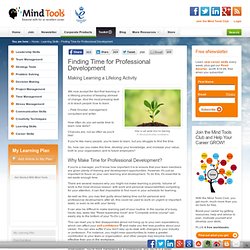
And the most pressing task is to teach people how to learn. – Pete Drucker, management consultant and writer. How often do you set aside time to learn new skills? Chances are, not as often as you'd like! If you're like many people, you're keen to learn, but you struggle to find the time. So, how can you make this time, develop your knowledge, and increase your value, both to your organization and to future employers? Why Make Time for Professional Development? If you're a manager, you'll know how important it is to ensure that your team members are given plenty of training and development opportunities. There are several reasons why you might not make learning a priority. It can also be difficult to make learning part of your routine.
Continuous learning can also help you develop expert power . Community Hub. Learning Port - List of Available Resources. Bringing resource based education to our local partners Welcome | Sign up for Email Updates » 9 Results 470 results found | Showing 1-20 of 470 Massachusetts Department of Elementary and Secondary Education.
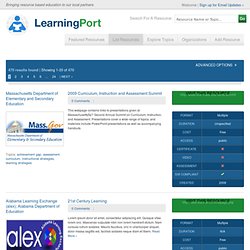
Creating spaces where knowledge can be shared-about the shaping of space and knowledge sharing. “In order for something of quality to take place, an empty space has to be created.
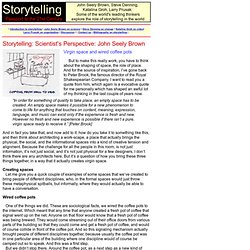
An empty space makes it possible for a new phenomenon to come to life for anything that touches on content, meaning, expression, language, and music can exist only if the experience is fresh and new. However no fresh and new experience is possible if there isn’t a pure, virgin space ready to receive it.” [Peter Brook] And in fact you take that, and now add to it: how do you take it to something like this, and then think about architecting a work-scape, a place that actually brings the physical, the social, and the informational spaces into a kind of creative tension and alignment. Because the challenge for all the people in this room, is not just information, it’s not just social, and it’s not just physical for a few designers, I don’t think there are any architects here, But it’s a question of how you bring these three things together, in a way that it actually creates virgin space.
Wired coffee pots. Communities of Practice. Communities of Practice are groups of people who share a concern or a passion for something they do and learn how to do it better as they interact regularly.1 1 Etienne Wenger, Communities of Practice: A Brief Introduction.

June 2006. (accessed October 2011). Regional Communities of Practice To provide opportunities for California adult educators to interact regularly and to engage in collective learning, CALPRO is offering regionally based professional learning opportunities using a Community of Practice (CoP) model on a growing number of priority topics. Available Topics and Descriptions: To view a description of each topic, click on its title. Blended Instruction In these regional CoPs, participants meet face-to-face and also online to receive guidance and support in implementing new practices in their schools and agencies. Average Time Commitment Shift in Culture Benefits of Participating in a CALPRO regional CoP: For More Information.